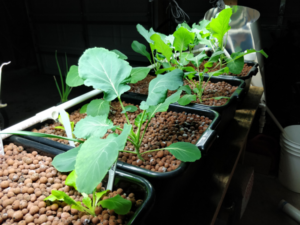
Hello, hello, hello! Today is a fun one for me as I get to dive into the gardening section of blogging, specifically with a focus on Hydroponics. If you are close to the gardening world, it may seem to be all the rage now-a-days. It is a really cool way to grow and is great because it uses a lot less water than a traditional soil garden. It is not a silver bullet or a replacement form of growing, but rather an alternative. With that being said, if you have never heard of it before, I hope this introduction will give you a better understanding of hydroponics.
In it’s simplest form, hydroponics is a method of growing plants in a medium (expanded clay, rocks, perlite, etc.) without the use of soil by keeping the roots in contact with water. The water contains water soluble nutrients formulated to promote plant growth. To anyone who gardens, you may be scratching you head right about now because when thinking about growing in soil you have to ensure proper drainage to avoid “drowning” your plants. Also, you want to avoid root rot as well. It pretty much defies logic in this regard, however, I promise that it does work.
Recently it seems that hydroponics has become really mainstream, however, the method is not new at all. Historically, it has been found that the Roman empire used it and I have read that the Aztecs used this method as well. So, we are talking about 1600’s type of dates. Also, there are some researchers that believe the Hanging Gardens of Babylon may have used a form of hydroponics and this was during BC times. The jury is still out on this one though, but the gist is we did not recently event this growing method. We (people) are really good and “repackaging” ideas of old and presenting them as something new and as our own, but that is a different topic. However, if you do a web search on the history of the hydroponics, you’ll find some pretty interesting information out there.
If you look at what people are doing with their systems, upon first glance, it can seem like a daunting task. Personally speaking, I had to do a lot of research and reading to understand just how this method of growing works. Eventually, I get to a point where I cannot continuously consume information. I get bored easily and have to become hands-on since I learn best through trial and error. So, in January of 2017, I finally decided to stop looking and to start building my own hydroponic system in the garage. Before I did this though, I had to make a few decisions.
First of all, there are six basic methods (or techniques) for growing hydroponically and they all range in complexity from simply to pretty advanced. Alphabetically, they are as follows:
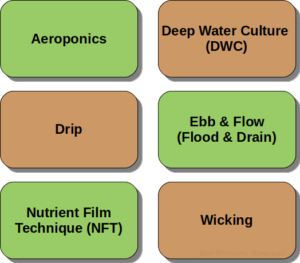
Now, I will take little time to go into each type. I won’t do a deep dive into the minute details, but hopefully it will be enough information to give you a basic understanding. One thing you will notice with every hydroponic method is the use of a reservoir of aerated nutrient water. To aerate something is to add air/oxygen into it. The only exception to this would be the Aeroponics as you will read below.
Aeroponics – This is a pretty advanced method of hydroponics. Rather than keeping the roots submerged in water, the roots are left open to the air inside of the reservoir. At certain times throughout the day, the roots are sprayed with nutrient water. The roots then absorb the water that it needs and the excess water falls back into the reservoir to be recycled. Because the roots are exposed to the air, they are surrounded by oxygen at all times when sprayed, so there is no need to aerate the water. Below is an example of how an Aeroponic example could look.
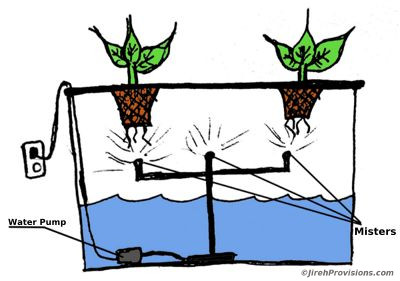
Deep Water Culture (DWC) – This is one of the simplest methods of hydroponics because there are no moving parts and everything can be contained to one container. The plants are supported above a reservoir usually in some type of growing cup that contains a medium. In addition, the roots dangle below into the nutrient water and the water is oxygenated by pumping air into it using an air stone (or something similar). As illustrated below, when the plant uses water, the water level drops while the roots continue to grow longer to remain in contact with the water.
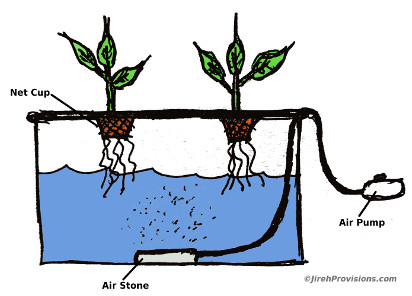
Drip – With this method, the nutrient water is fed into individual growing containers that have growing medium. A timer is used to supply nutrient water to the plants at specific times through the day. The excess water drains out of each of the growing containers and is returned back to the reservoir to be recycled. There is a variation on this method as well, where the water is not recycled, but goes through each growing container and the excess goes to a waste water reservoir. This of course is wasteful, but the trade-off is that the grower doesn’t have to worry about keeping the nutrient levels balanced as the plants utilize them. Recycling the water saves, but one has to be careful about which nutrients have been consumed. This is especially important when growing different types of plants together. (Note: The balance of nutrients as the water is used is not just a problem with the drip method but with any method of hydroponics).
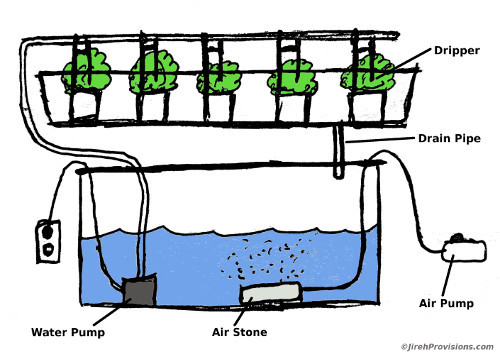
Ebb & Flow (Flood & Drain) – This method is exactly how it sounds and it involves the filling and draining of a grow bed with your plants. The plants are placed inside of some bed of growing medium then nutrient water is pumped into the bed. Once the water reaches a specific level, the water is siphoned out of the grow bed and back into the reservoir until it is nearly gone. Then the fill process begins again and cycle continues. The cool thing about this technique is that the water is siphoned out of the system by a device that requires no power at all, but only simple physics. One of the most popular ways to do this is to build something called a “Bell Siphon”. Another type of siphon that is growing in popularity is called the “U-siphon”. In each case, both work by having the water level reach a certain height inside the siphon. Once it does, a vacuum is created and the water is sucked out of the grow bed until it can be siphoned no more. When the siphoning breaks (or stops), this is what allows the fill process to begin again. I forgot to represent the siphon in the diagram below, but I wanted to mention it as it is important to the system.
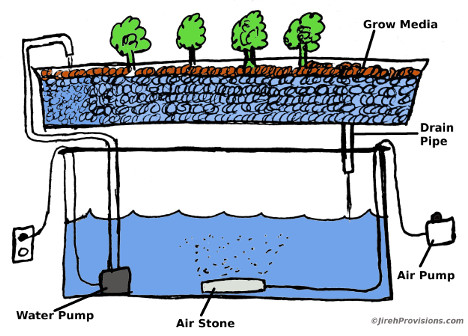
Nutrient Film Technique (NFT) – NFT is a hydroponic method that involves setting up a closed loop system using large pipes (or something which looks like rectangular covered gutters) with holes drilled into them. The holes are used for supporting the plants in their growing cups. Some people use net cups to drop into holes, while others keep it simple and use good old fashioned red Solo cups with holes in them. In any case, the roots drop into the pipes and sit along the bottom where a thin film (or low level) of water flows over the them. When the water reaches the bottom, it drains into the reservoir to be recirculated back through the system. If the system is designed as in the image below, then it is placed on some type of rack which allows the pipes to be angled so the water will drain. In other setups, the pipes can also be placed side-by-side on a table which is slightly angled for water flow. The principle occurs in that the water flows through one end of the pipes, out the opposite end, and sent back to the reservoir.
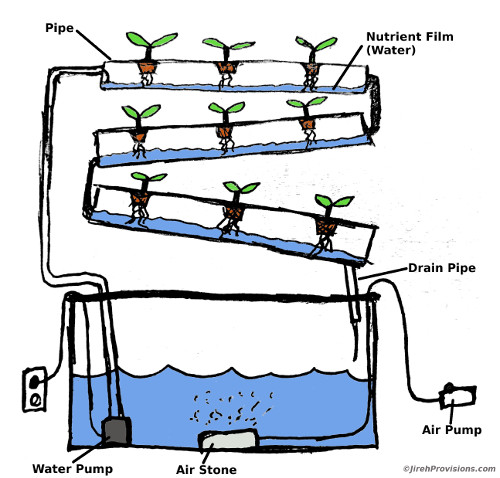
Wicking – This is another simple technique which requires no moving parts. You have a grow bed that holds the medium (missing in the image below) and the plants, while a wicking rope material (potentially cotton) is used to link the grow bed to the nutrient water reservoir. The wick draws the water up from the reservoir and provides the plants with oxygenated nutrient water. This method is good for plants that are not water hungry such as some quick growing lettuce and herbs.
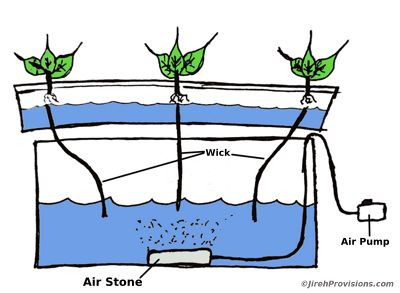
Again, the six methods above are the “main” ones, however, people do not always follow these to a “T”. You will see derivatives of them and the mixing of principles from each. It just really depends on the individual and how much you wish to experiment. I chose to create my first system based on the DWC method, however I ran into issues with water temperates and algae. I can go more into those issues in later posts as water temperatures are important. With my second system, I chose to use a method called the Dutch Bucket (or Bato Bucket) system and it’s a “drip” system. After a few months of using the Dutch Bucket system, I decided to change to the Flood & Drain technique and that is what I am using now.
Sheeew! That was a lot, but I am glad that you stuck with me through this introduction. Over the next few articles, I hope to dive further into my foray into hydroponics and share my experiences. Also, please excuse me for anything that I may have left out of the diagrams above. I hand drew them with an ink pen, photographed them with my phone, and then edited them with graphics software. I am by no means a graphic artist and consider myself graphically challenge, but I hope to get better as time progresses.
If you grow hydroponically, is there anything that I missed or misrepresented? If so, please feel free to share as I wish to share accurate information. If you don’t use this method at all and have questions, then feel free to drop us some lines in the comments. Thanks again for sticking around and stay tuned for more!
Pretty cool.!! Keep it up bro…!
Thanks man, will do. Might have to get you to weigh in on some aquaponics at some point!